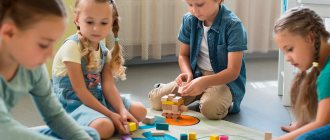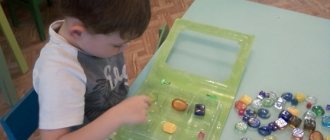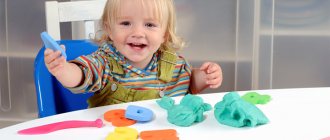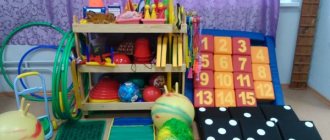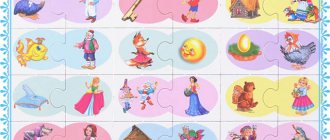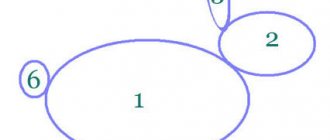Rules for organizing sensory education according to Montessori
Maria Montessori noticed that at a certain age, children's behavior and motivation are very similar. For example, in the first three years a child is especially sensitive to order. This childish “pedantry” is necessary for the child to create a stable image of this world. It can also be used to develop a child’s natural need for knowledge by creating tasks that are exciting for a certain age, which would help the child master the most important qualities of objects: color, size, shape, material.
As Maria Montessori herself admitted, the work of creating the sets was not easy: it was necessary to create material that would demonstrate properties in isolation, have pedagogical value, and at the same time be attractive to the child. This is how a set of Montessori sensory material appeared.
The main objectives of Montessori sensory exercises
- Teach the baby to perceive, compare and classify sensory experiences of different modalities,
- Expand the child’s sensory experience, teach him to notice even small differences, develop the child’s senses as much as possible,
- Teach your child to use his own memory: “I remember what yellow is, and I can always imagine it in my head,”
- Teach to critically evaluate any information and develop the habit of striving for maximum accuracy when gaining knowledge about the world,
- Create a basis for the emergence of abstract thinking and imagination.
Let us explain with an example how sensory and abstract thinking are connected:
Let's say you've never seen an okapi. Now your task is to imagine this animal by description: it is a bay horse with the legs of a zebra and the head of a giraffe. Happened? If so, congratulations, your sensory development is on point, because for this exercise you need to have an understanding of the colors of horses, the coloring of a zebra and the body structure of a giraffe.
Any abstract idea is essentially a clever interweaving of various information from our real experience. That is why a child’s intelligence begins in early childhood and the ability to exercise all the senses over and over again.
What can you find in the sensory development area of the Montessori center?
Visual information
- Shapes: sets of geometric shapes, as well as more complex shapes (for example, animal figures or plant leaves)
- Volumetric figures: Pink Tower, Brown staircase, Red barbells, Montessori weight cylinders
- Colors: sets of basic colors, card index of shades
Tactile information
- Texture: palpable board, rough tablets, baskets with rags
- Temperature: heat jugs, heat plates
- Weight: weighing cylinders and plates
Stereognostics
- Sorting small items, magic bag
Audio information
- Volume: sound boxes, musical accompaniment of classes
- Height: bells, sound cylinders, musical instruments
Taste and smell
- Taste bottles, conversations during meals
- Jars with scents
In addition to exercises with isolated sensory qualities, in a Montessori space you can always find sets that combine several qualities, such as color and shape:
- Binomial cube
- Trinomial cube
- Constructive triangles
- Montessori squares
- Cylinders without handle
The study of sciences according to M. Montessori also begins with sensory education. Acquaintance with the basic qualities of objects of the natural and cultural world prepares the child for studying social sciences, biology, physics, chemistry and even mathematics:
- Sets of leaves of different plants
- Thematic puzzles
- Maps and globe
- Flags
- Sets with natural materials
- Reproductions of artists and nature photographs
Why do you need a sensory room?
Every moment our body receives signals - visual images, sounds, smells, tactile sensations. Through the sensory organs, information enters the brain, which processes it. If perception becomes dull or, on the contrary, intensifies, then the brain incorrectly interprets the information received. In children, this often leads to problems with sensory integration—the organization of sensory signals that allows the brain to form appropriate responses in body and behavior.
If the child is okay with processing sensory signals, then a scratchy sweater or tight tights will only be a reason to complain to mom and ask her to buy others. In a child with a sensory processing disorder, any minor factors provoke hysterics.
That is why all child development specialists and psychologists recommend that children develop fine motor skills, let them touch and taste everything within reason, and walk barefoot on grass and stones. Unfortunately, with urbanization this is becoming increasingly difficult to do. Therefore, neuropsychologists recommend creating such an environment artificially - in sensory rooms.
Which children will benefit from a sensory room?
A sensory room is a place where a child develops his sensory sensations: he touches different objects by touch, listens to music, plays with sand and water. In such classes, children gain a wealth of experience that helps them establish sensory integration processes.
Sensory experiences are especially necessary for children with:
- disorders of speech, development, behavior;
- autism spectrum disorder;
- cerebral palsy;
- attention deficit disorder.
In such a room they can relax, relieve anxiety, and choose the sensations that they need. For example, walking barefoot on peas to relieve tension after wearing orthopedic shoes, or throwing a soft construction set into the wall after a quarrel with a friend.
For normotypical children (that is, without developmental disabilities), such a room will also become a “place of power.” Kids love unusual games with different textures, they love to relax on soft furniture or play with water.
How is the learning process organized?
Based on the emotional, physiological or psychological needs of preschool children, classes are divided into two forms: individual and group. From the point of view of psychological and pedagogical impact, the following areas are usually distinguished:
- Neuropsychological correction. It is used most often for children who lack the motivation to remember and assimilate new information, including knowledge of the world around them.
- Correction and psychocorrection of behavior. As practice shows, it is best used for children who experience frequent outbursts of anger, as well as isolation and lack of self-confidence. In addition, such classes show excellent results if it is necessary to remove the baby from a hyperactive or, conversely, passive state. Based on the specific problem, calming or stimulating measures are used. As a result, the child learns to cope with the control of his own emotions, find a common language with others, and also get rid of obsessive states.
- Correction of neurological problems and psychotherapy. Classes of this kind are especially effective when a child stutters, feels fears, and also experiences neuropsychiatric and mental disorders. Such training is usually carried out either individually or in groups of 2-3 children.
- Development classes. Most often used for children aged 1-3 years. They can also be used for older children, especially if they have problems with attention, memory, speech, imagination or imaginative thinking. As a result of this training, children learn to remember various information and also significantly expand their vocabulary.
Speaking about older groups in kindergartens, sensory rooms are often used for them as an effective tool in preparing for school. To do this, children develop skills for independent thinking, resistance to stress, motivation to study and other important aspects.

